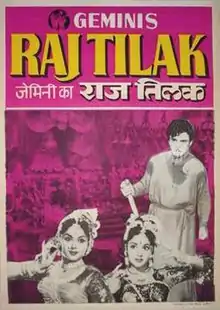Raj Tilak (1958 film)
Raj Tilak (transl. Crown Prince) is a 1958 Indian Hindi-language Ruritanian romance epic film written by the Gemini Studios story department, consisting of K. J. Mahadevan, C. Srinivasan and Kothamangalam Subbu, along with Ramanand Sagar, while the film was directed and produced by S. S. Vasan.[1] The film features Gemini Ganeshan, Padmini, Vyjayanthimala in the lead roles, along with Pran, Gajanan Jagirdar, Bipin Gupta, Manmohan Krishna, Lalita Pawar, Durga Khote, Agha, Shammi forming an ensemble cast.[2] The music was composed by C. Ramchandra.
| Raj Tilak | |
|---|---|
 | |
| Directed by | S. S. Vasan |
| Screenplay by | K. J. Mahadevan Ramanand Sagar |
| Story by | Kothamangalam Subbu K. J. Mahadevan Ramanand Sagar |
| Based on | The Count of Monte Cristo by Alexandre Dumas |
| Produced by | S. S. Vasan M. A. Partha Sarathy |
| Starring | |
| Cinematography | P. Ellappa |
| Edited by | N. R. Krishnaswamy |
| Music by | C. Ramchandra |
Production companies | |
| Distributed by | Gemini Pictures |
Release date | 1958 |
Running time | 171 minutes |
| Country | India |
| Language | Hindi |
The screenplay was written by Ramanand Sagar.[3][4] The film was a remake of 1958 Tamil film Vanjikottai Valiban.[5]
Plot
Chandrashekhar, shortly called Chandar, lives and works in a ship with his sister Savitri, they are raised by the ship's captain. Now, Chandar becomes busy for Savitri's marriage and fixes in a decent family. Before marriage, Savitri is abducted by Senapati Durjay Singh; to save her honour, she kills herself in front of Chandar. Enraged Chandar vows to take revenge on Durjan, but captured by his goons and jailed in a fort, where he meets his long-lost mother. There he learns of his past as he is the son of Mangalsen, who was the faithful Chief Minister under Maharaja Vikram Singh, who was killed by none other than Durjay; to save the Prince and Princess, Mangalsen took them with him, on the other side his wife took their son and daughter to escape by boats, however, Mangalsen managed to escape while his wife failed and was captured by Durjay's goons, leaving her children on the boat, separating them from their parents. Now, Chandar hits upon a plan for meeting his father as well as taking revenge on Durjay. However, his mother dies in the jail and Chandar manages to escape, ends up to be in a ship, which transports him to the arrogant Princess Mandakini, who wants Chandar as her slave for lifetime. On the other side, Mangalsen, who now becomes Sardar and trains the villagers, along with Princess Padma and Prince, for fighting against the evils.
Cast
- Gemini Ganeshan as Chandrashekhar "Chandar"
- Padmini as Princess Padma
- Vyjayanthimala as Princess Mandakini
- Pran as Senapati Durjay Singh
- Gajanan Jagirdar as Sardar Mangalsen
- Durga Khote as Mangalsen's wife
- Bipin Gupta as Maharaja Vikram Singh
- Manmohan Krishna as Madhav
- Lalita Pawar as Alka
- Romi as Prince
- Agha as Govind
- Shammi as Govind's wife
- Kumar as Ship Captain
- C. R. Vijayakumari as Savitri
- Meenakshi as Maharani
- T. K. Ramachandran as Gajpal
Soundtrack
The music was composed by C. Ramchandra and the lyrics were written by P. L. Santoshi.
| Song | Singer |
|---|---|
| "Dil Jo De Doongi Raja" | Lata Mangeshkar |
| "Aaj Na Jane Reh Reh Kyun" | Lata Mangeshkar |
| "Jaan-E-Jigar, Dekho Idhar" | Asha Bhosle |
| "Aaja Tu Raja Aaja, Mausam-E-Bahar Hai, Ambua Ki Meethi" | Asha Bhosle, Sudha Malhotra |
| "Chalna Sambhal Sambhalke Ji, Chalna Sambhalke" | Asha Bhosle, Mohammed Rafi |
| "Aayi Re O Kali Ghata" | Mohammed Rafi |
| "O Maa, Na Bolegi, Na Bolegi" | Manna Dey |
| "Bam Bholanath, Bam Bhola" | Manna Dey |
Inspirations and remakes
The film was a remake of 1958 Tamil film Vanjikottai Valiban, which also directed by S. S. Vasan with Gemini Ganeshan, Vyjayanthimala and Padmini.[5] The film itself was inspired by the 1844 novel The Count of Monte Cristo by Alexandre Dumas.[6]
References
- Randor Guy (23 May 2003). "With a finger on people's pulse". The Hindu. Archived from the original on 6 July 2003. Retrieved 8 January 2012.
{{cite news}}: CS1 maint: unfit URL (link) - Subhash K. Jha (Indo-Asian News Service) (1 April 2010). "Southside Male Bollywood". IndiaGlitz. Archived from the original on 4 April 2010. Retrieved 8 January 2012.
- Subhash K. Jha (Indo-Asian News Service) (13 December 2005). "Ramanand Sagar: TV and cinema's blockbuster man". IndiaGlitz. Archived from the original on 16 January 2014. Retrieved 8 January 2012.
- "Ramanand Sagar: A writer's sensibility". The Tribune. 25 December 2005. Retrieved 6 March 2012.
- Randor Guy (26 March 2011). "Vanjikottai Vaaliban 1958". The Hindu. Retrieved 8 January 2012.
- Ramachandran, T.M (1985). 70 Years of Indian Cinema 1913 to 1983. I B D Ltd. p. 78. ISBN 978-0-86132-090-5. Retrieved 4 June 2011.